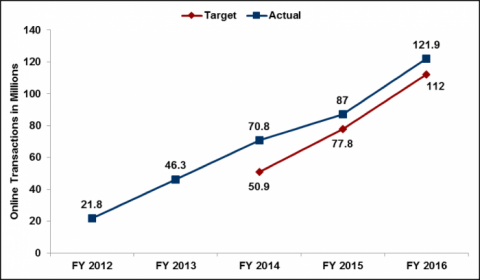- Home
- Agencies
- Department of Agriculture
- Department of Housing and Urban Development
- General Services Administration
- Department of Commerce
- Department of the Interior
- National Aeronautics and Space Administration
- Department of Defense
- Department of Justice
- National Science Foundation
- Department of Education
- Department of Labor
- Office of Personnel Management
- Department of Energy
- Department of State
- Small Business Administration
- Environmental Protection Agency
- Department of Transportation
- Social Security Administration
- Department of Health and Human Services
- Department of the Treasury
- U.S. Agency for International Development
- Department of Homeland Security
- Department of Veterans Affairs
- Goals
- Initiatives
- Programs
SSA Online Service Initiative Takes Off
What’s the issue?
The Social Security Administration’s (SSA) programs touch the lives of nearly every American and are vital to our nation’s economy. In FY 2016, SSA paid almost $968 billion to nearly 66 million beneficiaries and recipients. Social Security faces a major challenge from the retirement of the largest generation in American history, the 76 million people born from 1946 through 1964. Baby boomers began to reach age 66 in 2012 at the rate of 10,000 a day. SSA must find ways to meet the changing needs of our customers by offering more efficient service choices.
What was the intervention?
SSA’s goal is to increase customer choice in how we do business by increasing the variety of online services. In addition to being convenient for the customer, increased use of online services allows SSA to reduce the average time our employees spend processing claims, freeing them to handle the more complex workloads and the individuals who require in-person help.
Over the last few years, we implemented several new, secure and easy-to-use online services including: Application for Retirement Benefits, Application for Medicare Benefits, Application for Disability Benefits, Appeal of Disability Claim, and Application for internet Social Security Number Replacement Card (iSSNRC). Customers can now create a my Social Security account online and check their online benefits verification letter, start or change a direct deposit, and get a replacement Medicare card, SSA-1099, or SSA-1042S. Customers also can use the retirement estimator to view their earnings record, get their Social Security Statement, and request a replacement Social Security card. Social Security Income recipients can report their wages using the Mobile Wage Reporting application.
SSA’s online services continue to be highly rated. In FY 2016, 7 of the 8 SSA online applications exceeded the ForeSee E-Government Satisfaction Index with scores of 80 or higher. A score of 80 or higher is considered the threshold for excellence.
How was performance management useful?
The online services initiative is an Agency Priority Goal (APG) and has very specific and aggressive targets, demonstrating SSA’s commitment to improving customer service. We are required to hold quarterly Internal Performance Reviews where we discuss APG strategies and key initiatives, make course corrections, and report on progress to date. SSA’s Analytic Center of Excellence provides evidence-based analysis to help make informed decisions, manage risks, and improve overall customer satisfaction.
What was the impact?
Since FY 2012, customers have completed increasing numbers of online transactions. For example: We improved access to our services in FY 2016 by increasing the number of citizens who complete their business with us online by more than 40 percent over FY 2015.

Moreover, since November 2015, we have issued over 100,000 Social Security number replacement cards using the new online service. The application provides users with a secure way to request replacement Social Security number cards online, avoiding travel time, wait time, and in-person interviews. Additionally, our employees have more time to process other workloads. Currently, 14 states and the District of Columbia offer this service. In FY 2017, we plan to add more states to this growing list.




